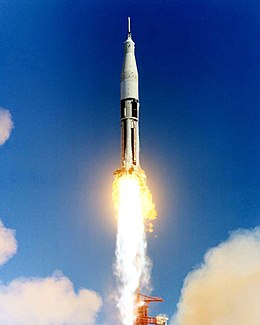AS-201

Launch of AS-201, the first flight of the Apollo spacecraft and Saturn IB launch vehicle
|
|||||
| Mission type | Suborbital test flight | ||||
|---|---|---|---|---|---|
| Operator | NASA | ||||
| Mission duration | 37 minutes, 19.7 seconds | ||||
| Range | 8,477 kilometers (4,577 nautical miles) | ||||
| Apogee | 492.1 kilometers (265.7 nautical miles) | ||||
| Spacecraft properties | |||||
| Spacecraft | Apollo CSM-009 | ||||
| Manufacturer | North American Aviation | ||||
| Launch mass | 15,294 kilograms (33,718 lb) | ||||
| Start of mission | |||||
| Launch date | February 26, 1966, 16:12:01 UTC | ||||
| Rocket | Saturn IB SA-201 | ||||
| Launch site | Cape Kennedy LC-34 | ||||
| End of mission | |||||
| Recovered by | USS Boxer | ||||
| Landing date | February 26, 1966, 16:49:21 UTC | ||||
| Landing site | North Atlantic Ocean 8°56′S 10°43′W / 8.933°S 10.717°W |
||||
|
|||||
AS-201 (or SA-201), flown February 26, 1966, was the first unmanned test flight of an entire production Block I Apollo Command/Service Module and the Saturn IB launch vehicle. The spacecraft consisted of the second Block I command module and the first Block I service module. The suborbital flight was a partially successful demonstration of the service propulsion system and the reaction control systems of both modules, and successfully demonstrated the capability of the Command Module's heat shield to survive re-entry from low Earth orbit.
The Command and Service Module CSM-009 was a Block I version, designed before the Lunar Orbit Rendezvous method was chosen for the Apollo lunar landing; therefore it lacked capability to dock with the Apollo Lunar Module. Block I also employed preliminary designs of certain subsystems, and was heavier than the Block II version with lunar mission capability. All previous command and service modules flown (with one exception) were boilerplate versions.
CM-009 was the second production Block I command module to fly, the first being CM-002 flown on a Little Joe 2 rocket for the final Launch Escape System abort test, designated A-004. CM-009 varied from the production configuration by the omission of the guidance and navigation system; crew couches, displays, and associated equipment; and by the addition of a control programmer and open-loop emergency detection system.
SM-009 was the first production Block I service module to fly. It varied from the production configuration by replacement of the electrical power-generating fuel cells with batteries, and omission of the S-band communication equipment.
The launch also included a Block I Launch Escape System (LES), and the first flight of the Spacecraft-LM Adapter (SLA) which connected the spacecraft to the launch vehicle.
The Saturn IB was the uprated version of the Saturn I rocket flown in ten earlier Apollo missions. It featured an upgrade of the first stage engines to increase thrust from 1,500,000 lbf (6,700 kN) of thrust to 1,600,000 lbf (7,100 kN), and replacement of the second stage with the S-IVB. This stage used a new liquid hydrogen-burning J-2 engine which would also be used on the S-II second stage of the Saturn V lunar launch vehicle. A modified version of the S-IVB, with an in-space restartable J-2, would also be used as the third stage of the Saturn V. It also used a new model of the guidance and control system known as the Instrument Unit, which would also be used on the Saturn V.
...
Wikipedia
